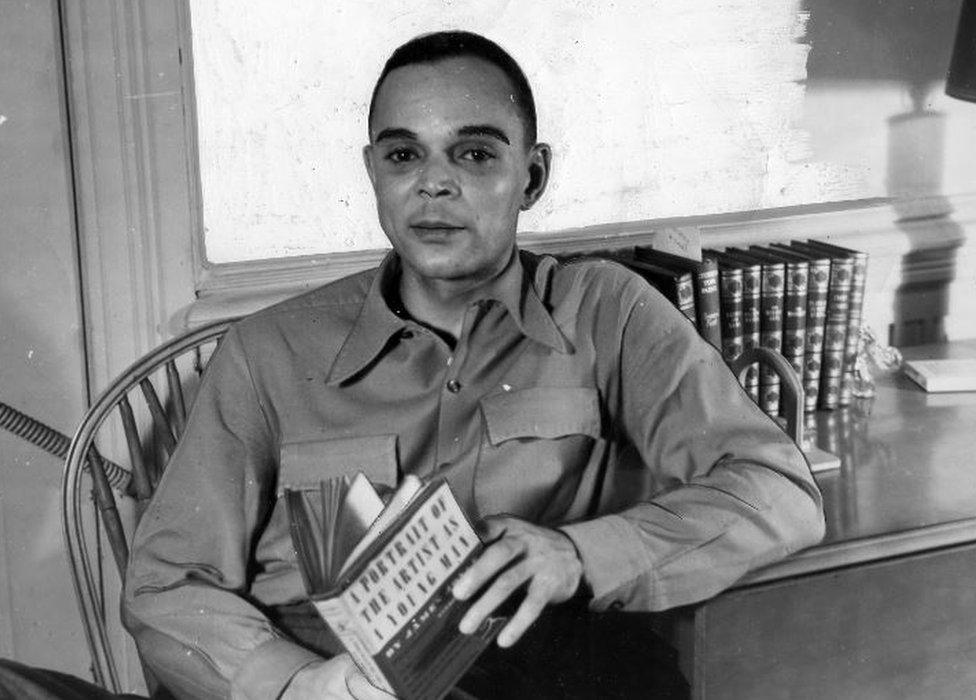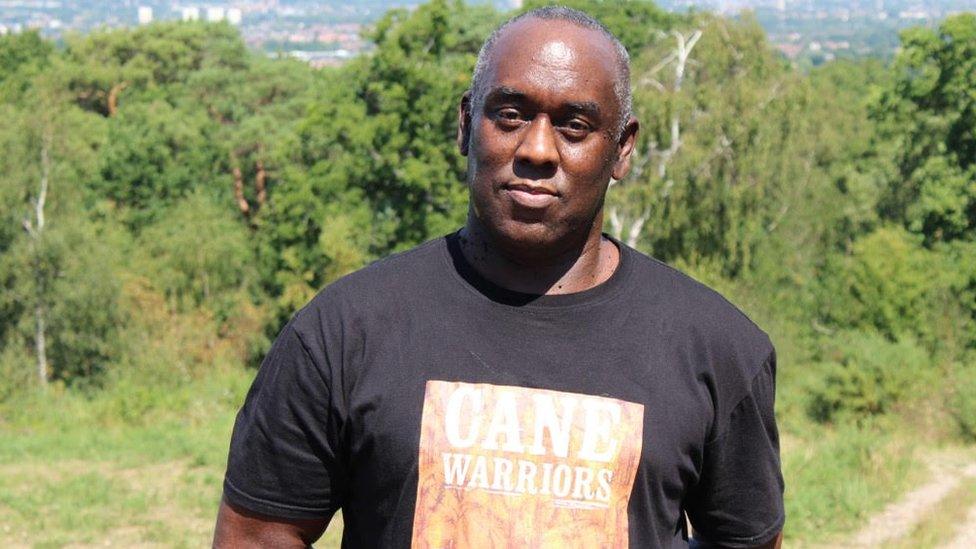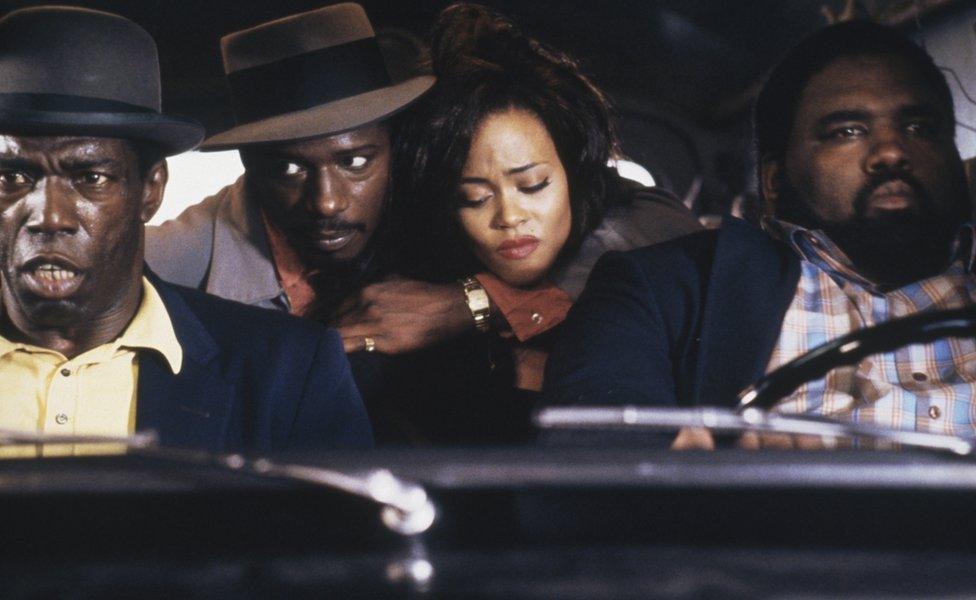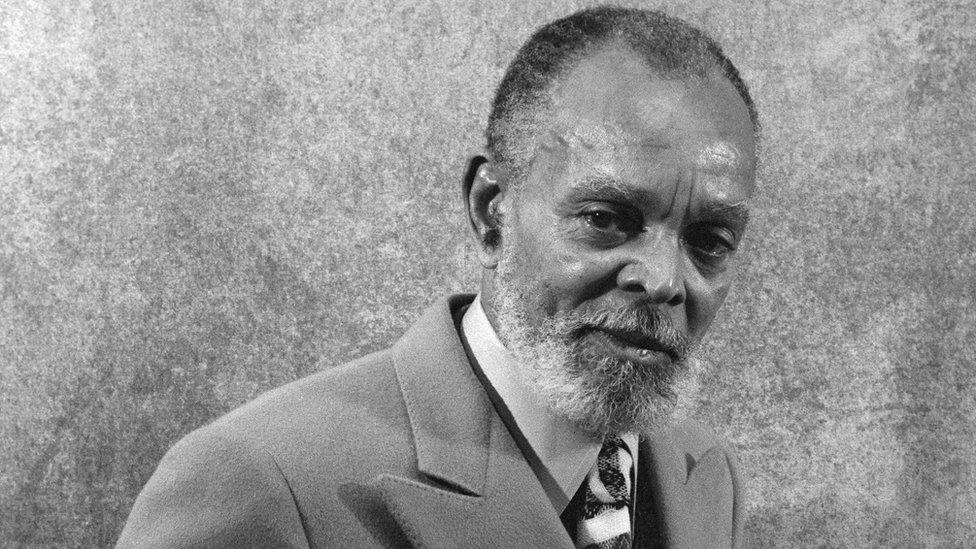Alex Wheatle: Why the 'amazingly exciting' Chester Himes should be better known
- Published

Alex Wheatle fell in love with Chester Himes' novels whilst in prison
In 1981 Alex Wheatle served time in prison in London following the Brixton riots. His teenage life was turned around by another prisoner who suggested he should start reading the work of black writers - it was the creative spark for his own career as a novelist.
The reading-list included Chester Himes - the "amazingly exciting" American crime writer Wheatle says should be better known.
The moment Wheatle fell in love with black writing is dramatised in a film from Steve McQueen's Small Axe season on BBC One, which airs on Sunday.
Cellmate Simeon tells Wheatle he needs to know more about black culture - British and otherwise. We see Wheatle (played by Sheyi Cole) pick up the history book The Black Jacobins.
But Wheatle, now an author with 15 books to his credit, says the fiction novels which gripped him most in jail were those of Chester Himes.

Chester Himes' stories are set in Harlem and feature the New York detectives Coffin Ed Johnson and Grave Digger Jones
Himes was born into a middle-class family in Missouri in 1909. He died in 1984 - not long after Wheatle discovered his dynamic, hard-driven crime stories such as A Rage in Harlem and The Real Cool Killers.
Wheatle says he enjoyed non-fiction by the likes of CLR James "but when I asked my cellmate for novels to relate to my life as a young black guy in early '80s London he said there wasn't much and I should read Chester Himes".
"I found his books amazingly exciting - the stories set in Harlem featuring the New York detectives Coffin Ed Johnson and Grave Digger Jones.
"But what really piqued my interest was when I realised Himes had been in prison too - in his case for years. It's where his writing career began and now I see a parallel."
Pim Higginson, who wrote The Noir Atlantic, about Himes and his influence on other writers, says Himes has always been read by small group in the US
"But he became a literary star in Europe because in his 40s he moved to France and later to Spain. Even now I think the majority of his readers are in France," says Higginson.

Sheyi Cole as Alex Wheatle in one of director Steve McQueen's Small Axe films
"He was a hugely irascible man and a chronic alcoholic. He could be very difficult with publishers. But it's all part of what makes him interesting."
Higginson says even as a teenager Himes' life had clearly been going wrong. "The people he hung around with were prostitutes and pool-sharks and gamblers and various underworld types. Then in 1928 he was sentenced to a minimum of 20 years for violent armed robbery."
It was from the Ohio State Penitentiary that Himes began to submit stories to magazines. He built a reputation writing in grim surroundings and was paroled in 1936.
The first published novel, If He Hollers Let Him Go, came nine years later. It's an unstinting account of the racism the central character faces in wartime Los Angeles.

Alex Wheatle says that before discovering Himes he had "never read anyone who wrote in that raw way"
Higginson says it's the non-crime novel by Himes which today's readers are most likely to encounter. "Post-war it won Chester an audience in America, even if the follow-ups did less well. But in 1953 everything changed totally because he left America for good."
Higginson says the author's reasons for going to live in Europe were involved. "Himes had a complex relationship with his own racial identity.
"His father had been very dark-skinned and his mother very light-skinned. He wasn't one of the African American authors who expected that going to live in Paris would mean a total escape from racist attitudes at home.
"But Chester wanted to reinvent himself as a writer and he did exactly that."

Rage in Harlem is one of the films to be made from Himes' stories
The New York setting used in Himes' crime stories - which delighted Wheatle with its vigour and wit - emerged in books published in France and later in Spain.
Starting in 1945 the Série noire paperbacks brought out hard-boiled American crime fiction in French translation. The publisher told Himes he could profitably turn his hand to stories which contained violent murder, an American locale and strongly drawn characters.
Himes wrote in English but the pages were translated almost as they left his typewriter. French readers loved the stories.
Wheatle says as a young man he too gobbled up the stories of detectives Coffin Ed Johnson and Grave Digger Jones. The next car chase or shoot-out or grisly death is seldom far away.
"I think what I found most distinctive was the picture of Harlem life. It was so vivid I could almost smell the streets and the characters on the streets. I'd never read anyone who wrote in that raw way.
"It was the closest thing I'd ever read to what was going on in those days in Brixton. He was writing about New York but I could see parallels with the relationships between people on the street and with the police.

Chester Himes wrote eight Harlem novels plus one left unfinished
"Sometimes the police in South London would treat people brutally and you get that in Chester Himes too. I had to flinch at the rawness and violence in his books and what people did to each other."
He says reading Himes made him more confident about presenting narratives he knew. "I saw he'd done something like it already in a US context and he made me see that those stories of black life were valid.
"The characters I was writing about deserved their place in fiction and without Chester Himes I'm not sure I would ever have done it.
"He started writing his crime novels more than 60 years ago. But the issues he addresses are alive today. Chester Himes writes about unemployment and what people might do to get out of the poverty trap.
"Crime and desperation are still with us and that's what's underneath in his stories even if they're fun to read."
Himes wrote eight Harlem novels plus one left unfinished. Coffin Ed and Grave Digger and the other characters are so memorable it's surprising there have been no recent screen versions.
The films Cotton Comes to Harlem and Come Back Charleston Blue are now almost 50 years old. A Rage in Harlem, starring Forest Whitaker and Danny Glover, came out in 1991. Maybe it's time TV and movie producers looked again at the works of Chester Himes.
A BBC World Service Witness History programme to accompany this piece is available to listen now.